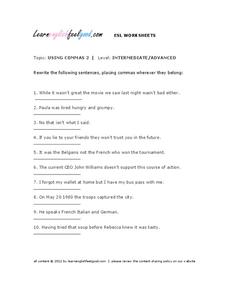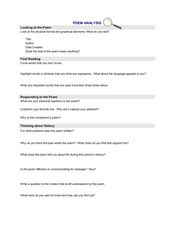Curated OER
Taming of the Shrew: Act 4.4, Study/Discussion Questions
This 4-question handout addresses key elements of Act 4.4 of Taming of the Shrew. It is intended for small group discussion, followed by individual written reponses. The prompts require critical thinking and analysis.
Curated OER
Sight Words Practice
Just cut along the dotted line and you've got sight word flashcards! Intended for new readers, these 2 and 3-letter words will become familiar the more your learner sees them. There are tweleve words in all. Be sure to shuffle you...
Macmillan Education
Understanding Poetry
William Wordsworth's "Daffodils" provides young poets with an opportunity to examine how a poet can use powerful images and poetic devices to create vivid pictures in the minds of readers.
Curated OER
Practicing Circles
Get your writers ready to print curved letters using this whimsical instructional activity. They trace 14 circular elements in an underwater scene, following the arrow and trying to stay on the dotted line. There are large and small...
Curated OER
Make Your Mark
In this sketching learning exercise, students complete activities where they sketch items in the Metropolitan Museum of Art. Students complete 5 activities.
LearnEnglishFeelGood.com
Using Commas, ESL
Put those comma skills to the test with a straightforward practice exercise. Learners rewrite 10 sentences to include the missing commas.
Curated OER
Commas and Nonessential Elements Exercise 2
In this comma learning exercise, students are given ten sentences and must determine whether the sentence is correctly written. Students must correct the sentences and identify nonessential information.
Hampton-Brown
From "First Crossing"
Young scholars look closely at four tales taken from the collection of short stories, First Crossing edited by Donald R. Galloby. While examining the life of four teenagers and the lives they lead as U.S. immigrants,...
Soft Schools
Onomatopoeia in Literature
Identifying onomatopoeia is one thing; making an inference about the significance of the sound is more advanced. Young poets read a literary passage and identify the examples of onomatopoeia in each before naming the...
Soft Schools
Onomatopoeia
Drip drop goes the raindrop. Quack quack goes the duck. What other words have sounds? Reinforce the concept of onomatopoeia in a worksheet in which young poets identify animal sounds and items that make a given sound.
Office of Migrant Education
Poetry: Form, Syllables, Mood, and Tone
Looking for a resource to introduce homeschoolers and other out-of-class learners to the elements of poetry? Check out this packet that defines and illustrates important poetry terms.
Classics for Kids
Fun With Musical Words
Is concertmaster another term for conductor, or is he or she another person entirely? Learn the specifics of the role of concertmaster with an activity focused on classical music. After learners define the term, they...
Curated OER
A Midsummer Night's Dream Acts 1-2
Blank verse, stichomythia, soliloquy, allusion, oxymoron, malaprop? Readers of A Midsummer Night’s Dream will need to know these terms to successfully complete a study guide designed for the first two acts of Shakespeare’s comedy. The...
Curated OER
Much Ado About Nothing: Fun Trivia Quiz
Check to see if your pupils can identify characters and basic plot points from Shakespeare's Much Ado About Nothing with this online interactive quiz. While the content is not innovative, this basic quiz could be helpful as a sponge or...
Curated OER
Cause and Effect Worksheet 2
Why does Scout fear Boo? Why does George kill Lennie? Whether in literature or life, helping young learners recognize the relationship between actions and consequences is an important lesson. Have your class match twelve observable...
Curated OER
Baseball
In this poetry worksheet, students write a creative poem utilizing each of the first letters in the word baseball on each line and then come up with words that describe baseball using only those letters on each line.
Curated OER
A Separate Peace: Chapter 13 Reading And Study Guide
In this comprehension check worksheet, students define 3 vocabulary words, define 1 literary term, and respond to 6 short answer questions pertaining to chapter 13 of A Separate Peace by John Knowlesin order to help them better...
Curated OER
Poem Analysis
In this poetry worksheet, students select poems, read them, and then respond to 17 questions about the content, response, and history of the poem.
Curated OER
"Goodnight, Sweet Prince"- A Hamlet Quiz: Fun Trivia Quiz
Check for understanding of Shakespeare's classic play Hamlet using this 25 question multiple choice quiz from Fun Trivia. This quiz asks young literature scholars to recall information about the plot, characters and quotes from the play....
Curated OER
One-on-One with Hamlet: Fun Trivia Quiz
Studying Hamlet in your class? This helpful resource provides ten questions on plot understanding and quote identification. While you might not use this quiz verbatim, you might use the given questions to create your own quiz. Keep in...
Curated OER
Richard the Second #1: Fun Trivia Quiz
If you are working on Richard II in your class, you might find this brief online interactive quiz useful. While not the most innovative quiz, you might draw a few questions about basic plot understanding from this resource. If you use...
Curated OER
Richard the Second #2: Fun Trivia Quiz
Challenge your class to recall information about Shakespeare's Richard II. This online quiz provides fifteen questions based on characters and basic plot points. Use it as a check for understanding or a quick sponge activity. Since this...
Curated OER
Romeo and Juliet Promptbook - The Balcony Scene
In this Romeo and Juliet learning exercise, students view three versions of the balcony scene. Students discuss why the director chose the elements for the film versions. Students then complete a prompt-book activity analyze the setting,...
Curated OER
What is in the Newspaper?
In this language arts worksheet, students examine the parts of a newspaper by examining a front page format. Students match 5 elements to where they are on the page and answer 5 questions.

























